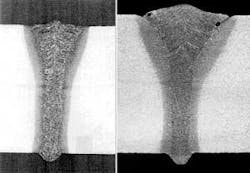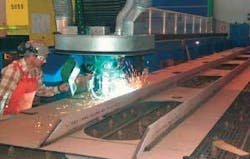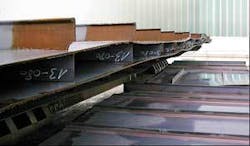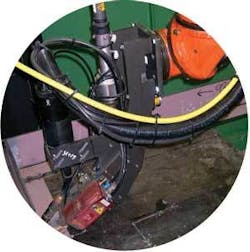Welding of structural steels
Laser welding offers many advantages, such as low distortion, high speed, and natural automation
Jens Klæstrup Kristensen
Significant changes have occurred in most parts of the world during the last couple of decades, and in many aspects these changes seem to be irreversible. Thus today it is trivial to state that the globalization trends will continue centered on an almost unhindered exchange of information, capital, and goods. In addition, among major concerns of society will be human welfare and sustainability. A future society therefore is seen as one that is based on (high) technology, free trade, and international competition, but also on integrated regional collaboration and international co-operation. The above scenario has important consequences on the way industry sectors and individual companies organize their production. New productive and automated industrial processes may be introduced to make industrial production less labor intensive.
Laser welding, due to its high power density, offers many desired advantages over traditional welding processes. These include high-speed seam welding, low distortion, single-pass welding in large thickness, easy automation, and positive effects on the working environment. For these reasons laser welding has experienced a dramatic increase in use in many industrial areas from light to heavy industry and especially the automotive industry.
Welding for structural applications
Important drawbacks related to high-power pure laser welding, especially in larger thickness, are found; especially enhanced demands on joint preparation and a limited ability to bridge a gap. Furthermore the welding speed is seriously reduced when welding joints with a gap beyond 0.5 mm. These restrictions can be reduced by taking advantage of a hybrid technique between laser and arc welding. In the fully synergetic hybrid processes the plasma formed at the interaction point of the laser on the workpiece surface controls the arc-root by reducing the cathode voltage drop, so that the interaction point becomes the same for the laser and the arc.
The TIG (GTAW), MAG (GMAW), and plasma arc welding processes may all be used in combination with the various laser sources. When welding thick parts and/or in the presence of a gap, hybrid laser using the MAG (GMAW) process is most advantageous because it is integrated in the process and it offers easy addition of filler material. In heavy section laser-MAG (GMAW) hybrid welding penetration is determined by the laser alone, but due to the arc the welding speed may be maintained at a high level even in the case of a relatively large gap. Thus an increased ability to bridge a gap as well as a significant increase in speed may be taken advantage of by using the hybrid process as compared to a pure high-power laser welding process, and surprisingly the heat input per unit length (and therefore also the distortions) is typically not increased significantly. A cross section of an arc-laser hybrid weld in 12mm structural steel is shown in Figure 1 together with a pure laser weld-for the given gap the welding speed is roughly doubled for the hybrid weld compared to the one obtained by the laser process alone.
Laser and laser-hybrid welding are now making an important impact on the medium and heavy section welding industry. The shipbuilding industry is leading in the introduction of high-power laser and laser-hybrid welding, but, for example, pipe and boiler manufacturing is also of high relevance. Many concrete initiatives have been taken recently and for example several European shipyards have already introduced the process; Meyer Werft in Germany is a well-known example, and Figure 2 shows another example from Odense Steel Shipyard in Denmark. The major motivation in shipbuilding is reduced distortion as it is estimated that between 20 and 30 percent of the man-hours used in shipbuilding is due to reworking caused by welding distortions. Figure 3 illustrates this very convincingly.
Hybrid laser weld properties
After more than a decade of intense work related to the mechanical and corrosion properties of welded joints as well as to the control of weld imperfections and defects, the process is now generally accepted by ship classification societies. Excellent properties can be obtained, but comparing the heat input per unit length for typical arc and laser based (pure or hybrid) welds for the same penetration or throat thickness, respectively, shows that the heat input in laser welds is typically almost an order of magnitude lower than in arc welds. It must therefore be taken into consideration that structural steels may harden in both the weld metal (WM) and the heat affected zone (HAZ) as a consequence of the fast thermal cycle inherently connected to processes. The resulting hardness does however depend very much on the composition of the steel and especially of the carbon content, and for this reason the classification societies unified guidelines for approval of CO2 laser welding procedures recommend to limit the carbon content to a maximum of 0.12 percent. In other additional guidelines recommendations are also given with respect to the avoidance of solidification cracking.
Excellent mechanical properties can, as mentioned, be obtained with CO2 laser. MAG (GMAW) hybrid welding and, as an example, the full Charpy V-notch transition curve for a weld in the 12mm S235 structural steel welded with an initial gap of 0.5 mm is shown in Figure 4. As seen, the transition temperature is below -40oC and due to the very tough structure the level of the high-temperature shoulder is significantly higher than the level of the base metal alone.
With regard to robotized welding, the CO2 laser sources do have significant limitations, which may be eliminated by using optical fiber-based laser sources instead. With respect to previous experience and background data, investigations into the obtainable quality have however, until now, only been performed to a limited extent. It may however be expected that the fulfillment of the above mentioned classification society recommendations generally results in very good mechanical and metallurgical properties. In Figure 4 we show the results obtained by hybrid Nd:YAG laser/MAG (GMAW) welding of structural steels.
Figure 5 shows a combined laser head for welding of T-joints using the hybrid Nd:YAG laser/MAG (GMAW) welding technique where the head includes a laser scanner that makes seam tracking as well as adaptive welding control based on the joint gap possible. Figure 6 shows the resulting welded cross section of a double sided T-joint between two 12mm plates of Grade S235 steel with 0.09 percent C and 1.39 percent Mn. The welds to the left have been performed at a speed of 1500 mm/min using a Nd:YAG laser power of 4 kW and a MAG (GMAW) power of 3.9 kW, that is, a total power of 7.9 kW at the workpiece. To the right is shown a cross section of a joint where the laser power has been increased to 5 kW, and a significant effect of increasing the laser power may be seen.
The properties are summarized below, but more details may be found in the bibliographic entries 3 and 4. The resulting maximum hardness in the weld metal was found to be roughly 360 HV5, and in the HAZ a slightly lower maximum hardness was observed. Transverse tensile testing using cruciform specimens resulted in fracture in the base metal at roughly 420 MPa. Transverse as well as longitudinal bend testing using a welded butt-joint simulating the T-joint properties resulted in an elongation upon minimum 25 percent.
Impact testing was performed using standard Charpy V-notch testing and the toughness of sub-sized 8mm specimens was in excess of 50 J down to -40oC with a few scattered occurrences of fracture path deviation (FPD). Again a welded butt-joint simulating the T-joint properties was actually tested. Also in fatigue, excellent results were obtained in transverse loading as well as in bending (see Figure 7).
Conclusions
The arc welding processes are cheap and reliable, but in light of the demands from modern society certain important limitations have become crucial. Many properties such as speed, heat input, and environmental aspects may not be improved further due to the limitations caused by the physics of the processes and the distortions observed in arc welding. Of equal importance are the large difficulties met in robotizing the processes where control of the individual weld-pass geometry is a key issue. Substituting with laser welding results in many advantages such as low distortion, high speed, and natural automation. Introducing laser/MAG (GMAW) hybrid welding instead of pure laser welding increases the ability to bridge a gap and provides a significant increase in speed when welding a wide gap, and excellent weld properties are obtained.
With regard to robotized welding, the CO2 laser sources have significant limitations, which for the most part may be overcome by using the optical fiber-based laser sources. Less background data exists in this situation, but in the present paper very good results are also reported in relation to Nd:YAG laser/MAG (GMAW) welding of structural steels.
Bibliography
1. Klaestrup Kristensen J, “Trends and Developments within Welding and Allied Processes,” The Houdremont Lecture at IIW International Conf. on Advanced Processes and Technologies in Welding and Allied Processes, The annual assembly of the International Institute of Welding (IIW) 2002, Copenhagen, Denmark (June 2002).
2. Laser Welding in Ship Construction ‑ Classification Society Unified Guidelines for the Approval of CO2‑Laser Welding (1996).
3. Welding J and Klæstrup Kristensen J, “Hybrid YAG-Laser/MAG welding, quality and stability,” Proc. of 9th NOLAMP Conference, Troendheim, Norway (August 2003) - To be published.
4. Gerritsen C H J, Weldingh, J and Klæstrup Kristensen J, “Development of Nd:YAG Laser-MAG Hybrid Welding of T Joints for Shipbuilding,” Proc. of 10th NOLAMP Conference, Luleå, Sweden (August 2005).
Jens Klæstrup Kristensen ([email protected]) is with Force Technology, Denmark.







